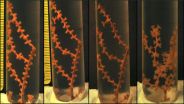(Press-News.org) The dispersant used to remediate the 2010 Deepwater Horizon oil spill in the Gulf of Mexico is more toxic to cold-water corals than the spilled oil, according to a study conducted at Temple University. The study comes on the eve of the spill's fifth anniversary, April 20th.
In this collaborative study between researchers from Temple and the Pennsylvania State University, the researchers exposed three cold-water coral species from the Gulf to various concentrations of the dispersant and oil from the Deepwater Horizon well. They found that the dispersant is toxic to the corals at lower concentrations than the oil.
The researchers' findings, "Response of deep-water corals to oil and chemical dispersant exposure," were published online in the journal Deep-Sea Research II.
Approximately five million barrels of crude oil escaped from the well drilled by the Deepwater Horizon oil rig in 2010, and nearly seven million liters of dispersants--chemical emulsifiers used to break down the oil--were used to clean it up. Normally applied to the water's surface, the spill marked the first time that dispersants were applied at depth during an oil spill.
"Applying the dispersants at depth was a grand experiment being conducted in real-time," said Erik Cordes, associate professor of biology at Temple, who has been studying Gulf of Mexico coral communities for more than a decade. "It was a desire to immediately do something about the oil coming out of the well, but they really didn't know what was going to happen as a result."
Following the 2010 spill, Cordes and his collaborators discovered several damaged Gulf coral populations that were coated with a dark colored flocculent slime that was found to contain oil from the spill and residues from the dispersants.
"We wanted to know if the damages that had been witnessed could have been caused by the oil, the dispersant itself, or a combination of both," said Danielle DeLeo, a Temple doctoral student in Cordes' lab, who was the study's lead author. "We know that the corals in the Gulf were exposed to all of these different combinations, so we have been trying to determine the toxicity of the oil and the dispersants, and see what their impact would be on the corals."
The researchers exposed the corals to a range of concentrations for both the dispersant and the oil to determine a lethal dose for each. They were surprised to find that the lethal concentration is much lower for the dispersant, meaning it is more toxic than the oil.
"It doesn't take as much dispersant to kill a coral as it does oil," Cordes said, adding that the oil in combination with the dispersant increases the toxicity of the oil.
Using dispersants is supposed to reduce the impact of oil spills on the environment, said Cordes, "but there's increasing evidence that's not what's happening."
Cordes said that his lab will be carrying out additional studies to try to replicate the concentrations of oil and dispersant that the corals were exposed to during the Gulf oil spill, but this is the first step in determining the toxic levels of dispersants and their impact on the environment. He said their findings could assist in developing future strategies for applying dispersants at oil spills that may be more helpful than harmful to the environment.
INFORMATION:
In addition to Cordes and DeLeo, the researchers included Iliana Baums and Dannise Ruiz-Ramos of Penn State. The study was funded by a grant from the Gulf of Mexico Research Initiative to the "Ecosystem Impacts of Oil and Gas Inputs to the Gulf" consortium.
Note: Copies of the study, as well as high-res images, are available to working journalists. E-mail pmoretz@temple.edu.
April 9, 2015 - A wealth of studies have shown that violent video games contribute to antisocial and aggressive behavior. But what makes those games appealing in the first place?
One possibility is that storytelling plays a role, particularly if it lets players engage in meaningful choices.
A new study suggests that non-violent video games that capitalize on such storytelling have prosocial benefits that could ultimately be helpful to clinical disorders such as autism.
"The motivation to engage in and enjoy video games corresponds with principals that apply to ...
Scientists at the University of York have discovered a potential new treatment for prostate cancer using low temperature plasmas (LTPs).
Published in the British Journal of Cancer (BJC), the study is the first time LTPs have been applied on cells grown directly from patient tissue samples. It is the result of a unique collaboration between the York Plasma Institute in the Department of Physics and the Cancer Research Unit (CRU) in York's Department of Biology.
Taking both healthy prostate cells and prostate cancer tissue cells from a single patient, the study allowed ...
FROSTBURG, MD (April 9, 2015)--Nitrogen fertilizers make it possible to feed more people in the world than ever before. However, too much of it can also harm the environment. Professor Eric Davidson, director of the University of Maryland Center for Environmental Science's Appalachian Laboratory, has been leading a group of scientists, economists, social scientists, and agriculture experts in figuring out how to produce more food while lowering pollution at the same time. He calls it a "Mo Fo Lo Po": more food, low pollution.
"The main objective is to produce abundant, ...
MINNEAPOLIS/ST.PAUL (4/9/15) - Research published in the open access journal Microbiome offers new evidence for the success of fecal microbial transplantation (FMT) in treating severe Clostridium difficile infection (CDI), a growing problem worldwide that leads to thousands of fatalities every year.
Research led by Michael Sadowsky, Alex Khoruts, and colleagues at the University of Minnesota in collaboration with the Rob Knight Lab at the University of Colorado, Boulder, reveals that healthy changes to a patient's microbiome are sustained for up to 21 weeks after transplant, ...
After decades in ornithological obscurity, one of the world's least-known birds is finally coming to light thanks to the persistence of a small group of researchers. Pablo Negret, Oscar Garzón, Pablo Stevenson, and Oscar Laverde-R. of the Universidad de los Andes have just published the results of their year-long study of the Black Tinamou (Tinamus osgoodi hershkovitzi) in The Auk: Ornithological Advances, including new ecological information as well as some of the first video and sound recordings of this elusive species.
The Black Tinamou is a chicken-sized bird ...
A simple test of the number of fish living on a coral reef can be used as a roadmap to restore degraded reefs and fishers' livelihoods according to a global study published in the journal Nature.
An international team of marine scientists surveyed more than 800 coral reefs worldwide to develop a diagnostic test of reef health.
"By studying remote and marine protected areas, we were able to estimate how many fish would be on a coral reef without fishing, and how long it should take newly protected areas to recover," says study lead author, Dr Aaron MacNeil from the ...
WASHINGTON - Recognizing and giving thanks for the positive aspects of life can result in improved mental, and ultimately physical, health in patients with asymptomatic heart failure, according to research published by the American Psychological Association.
"We found that more gratitude in these patients was associated with better mood, better sleep, less fatigue and lower levels of inflammatory biomarkers related to cardiac health," said lead author Paul J. Mills, PhD, professor of family medicine and public health at the University of California, San Diego. The study ...
A new device developed by UCLA engineers and doctors eventually help scientists study the development of disease, enable them to capture improved images of the inside of cells and lead to other improvements in medical and biological research.
The researchers created a highly efficient automated tool that delivers nanoparticles, enzymes, antibodies, bacteria and other "large-sized" cargo into mammalian cells at the rate of 100,000 cells per minute -- significantly faster than current technology, which works at about one cell per minute.
The research, published online ...
ANN ARBOR--Efforts to reduce the amount of phosphorus and other nutrients washing off farm fields and into Lake Erie shifted into overdrive after high levels of a bacterial toxin shut down the drinking water supply to more than 400,000 Toledo-area residents last August.
Nutrient levels help determine when and where rapid cyanobacterial buildups occur, as well as the size of those blooms. But what factors control their toxicity? The Great Lakes are home to dozens of common cyanobacterial species, but only a few are toxic troublemakers.
"We know what causes these blooms: ...
This news release is available in German. An international collaboration led by the research group of superheavy elements at the Japan Atomic Energy Agency (JAEA), Tokai, Japan has achieved the ionization potential measurement of lawrencium (element 103) with a novel-type technique at the JAEA tandem accelerator. Based on the empirically developed "actinide concept", and in agreement with theoretical calculations, in today's Periodic Table the series of actinide elements terminates with element 103, lawrencium (Lr). Now researchers have measured the first ionization ...


